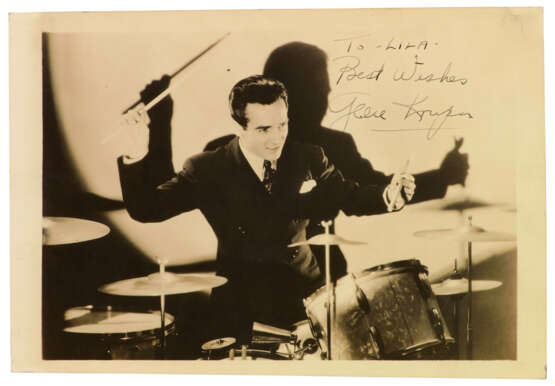A collection of manuscript scores used during recording of Louie Bellson and Gene Krupa’s rudimental drum instruction album The Mighty Two, 1963
28.09.2023 13:00UTC +00:00
Classic
Vendu
882GBP £ 882
| Auctioneer | CHRISTIE'S |
|---|---|
| Lieu de l'événement | Royaume-Uni, London |
| Commission | see on Website% |
Archive
La vente aux enchères est terminée. Vous ne pouvez plus enchérir.

ID 1016451
Lot 199 | A collection of manuscript scores used during recording of Louie Bellson and Gene Krupa’s rudimental drum instruction album The Mighty Two, 1963
Valeur estimée
£ 1 500 – 2 500
Louie Bellson and Gene Krupa
Louie BELLSON (1924-2009) and Gene KRUPA (1909-1973).
A collection of manuscript scores used during recording of Louie Bellson and Gene Krupa’s rudimental drum instruction album The Mighty Two, 1963, comprising 17 parts for eight songs, the parts in black ink in the hand of Louis Bellson, each part on two to four pages of ten stave paper, 317 x 242 mm, the title of each song printed at the head – Two in Love, Que Sticks, The Mighty Two, The Three Drags, Rolls Alla Bossa Nova, Rollas ala Bossa Nova 2, More Flams, Swingin’ the Rudiments, and Paradiddle Song – all but one (Paradiddle Song) including parts labelled for both Louie and Gene, with numerous autograph annotations in pencil, red pencil and blue ballpoint pen, the majority of the pencil annotations in Krupa’s hand, the remainder in Bellson’s, his rudiment “stickings” added in blue ballpoint pen below the song titles, and his supplemental manuscript pages added for many of the songs, some of the blue ink annotations being towards an uncompleted project for the publication of the pieces; housed in a red cloth solander box with chemise.
Bellson gifted the collection of drum parts to his friend and colleague Dave Black, explaining that they were the parts used during the recording sessions. Interviewed by Robyn Flans of Modern Drummer magazine in 1982, Charlie Watts declared: ‘There are very few people in this world who can play like Louis Bellson.’ Provenance: Dave Black (1928-2006, American jazz drummer).
[With:] a rare reel-to-reel master copy studio recording of Gene Krupa’s album Percussion King, recorded in New York on 5-16 June 1961 and released on Verve Records, 1961, the ¼-inch tape in original Bande Magnétique Pyral box with part-printed, part-handwritten label noting the client ‘Mr Barclay, Verve’, the transfer date 22 March 1962, and listing the tracks and matrix numbers; accompanied by Miller’s handwritten notes which additionally detail the individual musicians who formed Krupa’s 18-piece big band; housed in a custom cloth box. Miller notes that this copy was run for Eddy Barclay of Verve France and was previously a lost master until rediscovered in Barclay’s archives by Eric in the 1970s. Interviewed for the February 1990 issue of Modern Drummer magazine, Charlie Watts said of Krupa: ‘To me… Krupa’s great moments were not the drums solos but his time, and the way he’d spark the band. Like Let’s Dance on the Carnegie Hall album – it’s amazing. It’s only a double-time thing – I know what it is – but the way it lifts that orchestra is an incredible thing to hear.’ Provenance: Norman Granz (1918-2001; Verve founder) – Eric Miller (1941-2017; Granz’ assistant and protégé).
[And:] two vintage gelatin silver publicity portraits of Gene Krupa, c.1940, one signed and inscribed in black ink ‘To Lila – Best Wishes, Gene Krupa’, and the other inscribed ‘To Lila’ above Krupa’s printed signature, the largest 185 x 125 mm.
| Adresse de l'enchère |
CHRISTIE'S 8 King Street, St. James's SW1Y 6QT London Royaume-Uni | |
|---|---|---|
| Aperçu |
| |
| Téléphone | +44 (0)20 7839 9060 | |
| Commission | see on Website | |
| Conditions d'utilisation | Conditions d'utilisation |







